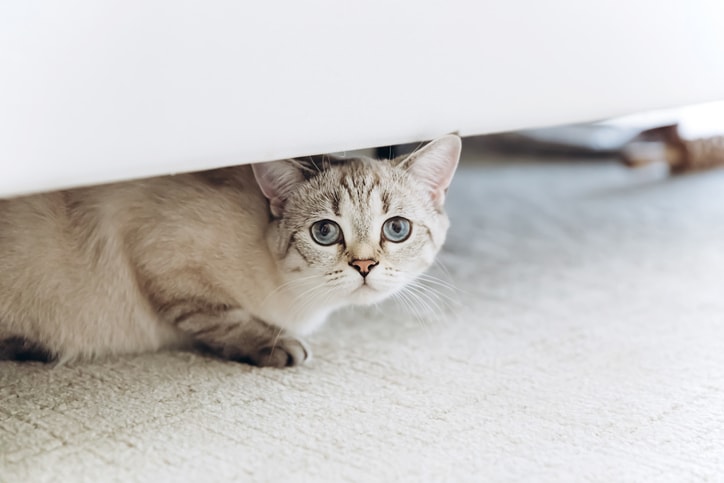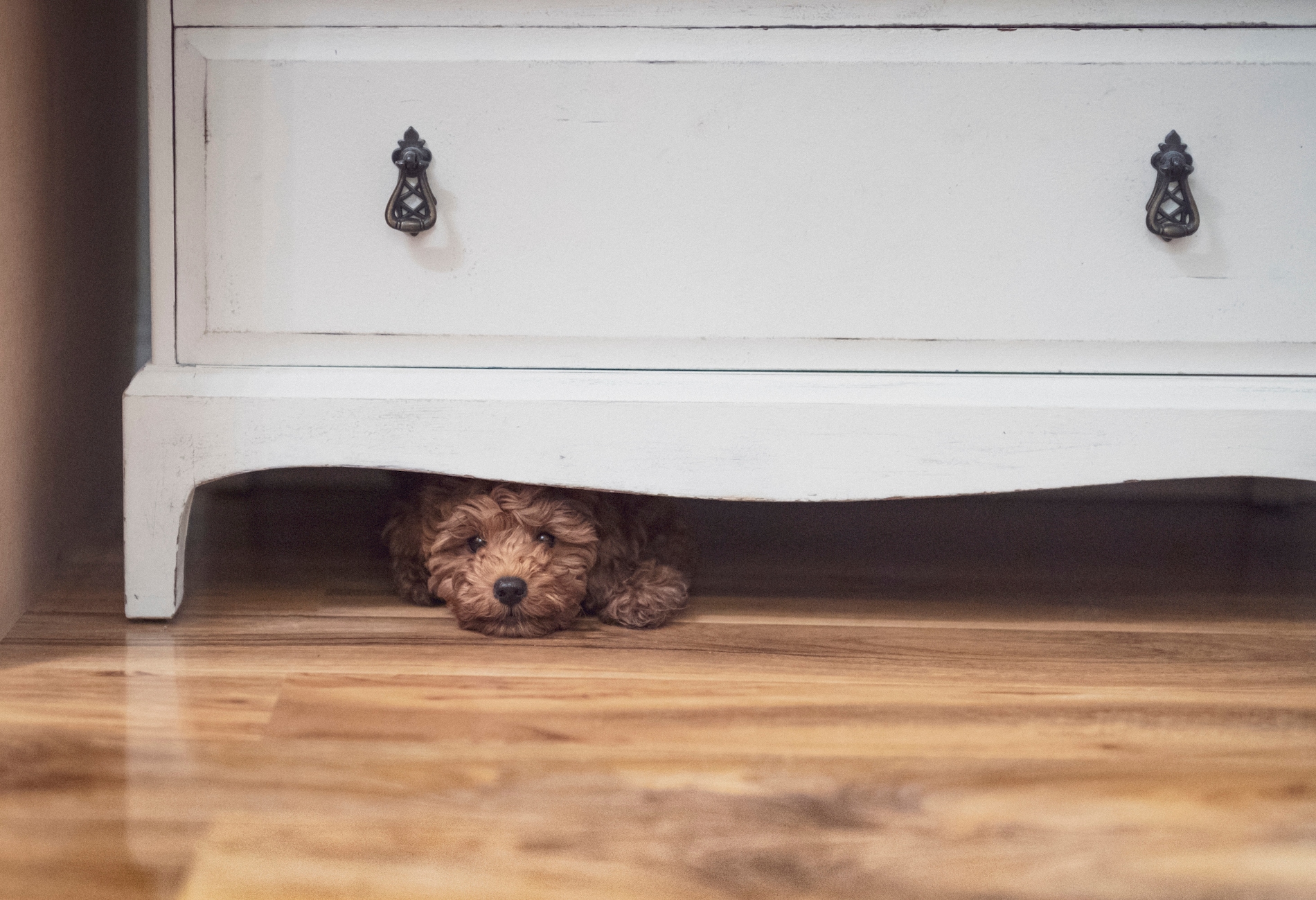In this article
Whether it’s a big move or adjusting to life with a newborn, all of us are plenty aware of just how stressful shake ups to our daily routine can be. But for cats? They can be downright unbearable.
“Change is difficult even for humans,” explains Dr. Christa Kahuda, the owner and medical director at Charleston Harbor Veterinarians in Charleston, South Carolina. “It is especially hard for our cats though because they don’t experience it often and don’t understand why it is happening.”
Luckily, there are simple ways to help your cat adjust to big life transitions. Here, experts break down what types of changes cause cats the most stress, signs they are struggling, plus tips on how to help them cope when forced to find a new normal.
Key takeaways
- Cats feel most comfortable when their surroundings are stable and consistent which is why big changes can result in big time stress for felines.
- The top three life events that cause the most stress in cats are introducing a new pet, welcoming new people into your home and moving houses.
- Signs of stress in cats often include unwanted behaviors such as urinating outside the litter box or scratching or clawing furniture and curtains.
- To minimize stress for cats during big transitions, the key is to go slow with changes and make sure they have adequate resources available to them at all times.
What causes the most cat stress and why?
Despite cats being prone to the occasional (yet totally unpredictable) bout of the zoomies, cat owners can consider their pets creatures of habit when it comes to their preferred lifestyle. Cats not only feel most comfortable when their surroundings are stable, but also when their daily routines are consistent. This is why major life transitions can cause major stress in cats.
“Cats — but especially our indoor-only cats — have very routine and safe lives,” Kahuda says. “They don’t usually ride in the car much, go for walks, or experience new things regularly so changes to those breaks to their routines may be more difficult for them to navigate.”
These are the top three life events that can trigger stress in cats, according to experts:
Bringing home new pets
Whether it’s a kitten, puppy or even an older adopted animal, new pets are infamous for causing cats to stress. “This is one of the top triggering events for felines because it can make them combative and start fighting over resources,” explains Dr. Grant Little, a Nebraska-based small animal veterinarian and veterinary expert with JustAnswer. These resources can include food, water, furniture and even attention from owners.
“Cats — but especially our indoor-only cats — have very routine and safe lives… so changes to those breaks to their routines may be more difficult for them to navigate.”
— Dr. Christa Kahuda, veterinarian
Welcoming new family members or roommates
From bedtime and mealtime routines to attending regular doctor appointments and school events, babies and kids in particular can shake up the dynamic of a household in a big way. “What this does is it changes the natural tenor, interaction, placement of objects and schedule from day to day,” explains Little. Cats can also experience stress when new adults enter the picture, too, whether it be a partner, roommate or extended family member.
Moving houses or apartments
For indoor cats, your house or apartment isn’t just a home, it is their entire world. So it’s not surprising that leaving it behind can cause stress as they get adjusted to a slew of new sights, smells and spaces. Outdoor cats also tend to have a tough time during moves since they entail traveling in carriers, car rides or even plane rides, often for the first time, according to Kahuda.
Keep in mind: It doesn’t take a full-on move to stress cats out when it comes to changes that occur in their environment. Even small alterations can cause big anxiety, especially if they affect the resources they depend on to survive. Here are a few examples, according to Kahuda.
- Switching to a new cat litter.
- Changing food or food bowls.
- Moving the location of furniture.
Pet owners going on vacation. (Yes, you are one of your cat’s most loved resources!)
What are the signs of cat stress?
Contrary to what pet owners may think, cats aren’t necessarily more prone to experiencing stress during big life transitions than say a canine counterpart. But the signs of stress in cats are much more noticeable than in dogs, according to Little.
“We do see dogs react, but stress can lead to more unwanted behaviors in cats that people don’t typically like, such as urinating in the house, defecating in the house or scratching or clawing up furniture and curtains,” Little says. “These things happen when a cat is not appropriately taken care of or the stress is not managed well within the house.”
Here are the top signs that your cat is experiencing stress related to a big event:
- Hiding.
- Decreased appetite.
- Urination or defecation outside the litterbox.
- Aggression toward humans or other pets.
- Destructive behavior such as scratching furniture or carpets.
The more drastic and prolonged the transition, the more likely you are to see multiple signs of stress in your cat, Little adds. “Cats are more isolated and aren’t required to have interaction or socialization as much compared to dogs or even people, so the quiet personality they have can be at odds with constant changes in the house.”
Are there long-term impacts of stressing out cats?
Since every cat responds differently to different stressors, it’s hard to pinpoint long-term effects of undergoing big life changes for felines. Rather than fearing the future, it’s best to focus on stabilizing your cat’s environment as quickly as possible after a major transition so they can get back on an even keel, according to our experts.
If signs of stress persist for more than a few days, however, Kahuda recommends speaking with your vet to be sure no serious health concerns with potential long-term effects have popped up.
How can you help manage cat stress during big transitions?
In general, slow and steady wins the race when it comes to tackling big life transitions in order to minimize stress for cats. Consider this your guide for how to do it, including specific tips and tricks for navigating common stressful scenarios from both cat owners and the experts at the Ohio State University (OSU) College of Veterinary Medicine, Kahuda’s go-to source when it comes to understanding how to help cats manage stressors.
1. Try to make changes to routines and resources as gradually as possible
The key to managing stress that comes as a result of unavoidable changes to your cat’s resources or routine is easing cats into them with preparation and patience. If you’re introducing a new cat, going slowly is particularly important, Little says, who recommends keeping new animals isolated at first, then slowly increasing interactions between them.
Here are a few more tricks to try based on your situation from OSU experts:
- Daily schedule changes: Increase the amount of playtime interaction or petting and grooming your cat receives to help reassure them when changes to their routine are unavoidable. If the cat will be alone for extended periods, ask a friend or relative who the cat is familiar with to visit while you are out.
- Temporary absence of a primary caretaker: Enlist the help of a cat sitter or family member in order to keep your cat at home when you go on vacation if possible. It’s also helpful to create a “safe space” for your cat to go to while you are gone with a piece of clothing or a blanket with your scent to make them feel that you are nearby.
- Bringing home a new baby: Before the baby is born you can help ease the transition for your cat by getting them used to the sounds and smells associated with babies by having a friend with a baby visit. When the baby arrives, try to keep the cat’s routine as normal as possible by allowing yourself time daily to play with your cat.
- New adults moving in: Creating a safe place and increasing play will also help in this scenario, especially if you involve the new person in play sessions with the cat. Playtime interaction that includes food treats can help to establish a positive relationship between the cat and the new person.
2. Talk to your vet about medications that can help with stress during travel
As a vet, Kahuda recommends starting cats on calming supplements and pheromones several weeks before traveling if possible. Your vet can also prescribe medications that can help with anxiety, which was the route pet owner Kelsey Murray took when she recently moved with her cat Oliver from Maine to South Carolina.
“For the actual drive, which took two days with a two-night hotel stay in the middle, I gave Oliver medication to help keep him calm,” Murray says. “The meds made him more lethargic and relaxed overall.” Murray then continued her cat on a lower dose of the medication once they arrived at the hotel to help him stay calm in the unfamiliar environment.
Murray also creates a “safe space” for Oliver while traveling in general, similar to one experts recommend making at home when owners leave for vacation. “I bring the blanket he sleeps on in the car and in the hotel and set it up on the same part of the bed he is used to sleeping on at home,” she says. “I think this is very dependent on the animal, but I also make sure Oliver has a view of me in the car because I think knowing I am there helps to keep him calmer.”
“Go slow with changes, make sure they have adequate resources available to them, and seek medical care when you are noticing health concerns.”
— Dr. Grant Little, small animal veterinarian
3. Put cats first when changing their environment
Anytime a cat’s surroundings are going to change, pet owners should take proactive steps to prioritize their needs which will help them adjust quicker. For example, when Murray arrived at their new home, Oliver’s cat perch, food bowls and litterbox were the first thing she unpacked.
“Once we finally made it to the new apartment, it took him about three days to fully settle in,” Murray said. “I didn’t continue the meds at that point, and instead let him sniff and explore freely to acclimate to his new home.” Here are more tips from the experts on OSU to manage cat stress in new and changing environments:
- Packing for a new move: Before packing begins, provide your cat with a refuge away from the chaos in a closed space which contains all the resources they need. Leave a radio or TV playing in or near the refuge to muffle confusing outside sounds.
- Arriving at a new home: When you arrive at your new home, recreate that same safe space and spend quality time with them there by playing with a favorite toy, petting her or brushing her. Leave the cat in the refuge until you have moved everything in and everyone else is settled.
- During the first few weeks in a new home: Once the house is in order allow the cat to investigate her new surroundings on her own. Leave the refuge available for the cat to come and go as she wishes until she is comfortable.
A final tip on helping cats manage stress
The best way to help cats manage stress during major life transitions is by staying attentive to their needs and allowing them ample time to adjust every step of the way. “Go slow with changes, make sure they have adequate resources available to them, and seek medical care when you are noticing health concerns,” Little says.
If you spot signs of stress in your cat during a big life transition, experts advise giving your pet a few days to see if the symptoms improve as things settle down. But if they persist, especially a lack of appetite coupled with vomiting, then it’s time to see your veterinarian, Little advises.





